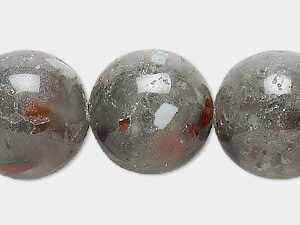Bloodstone Meaning and Properties
Bloodstone History
Also called heliotrope, bloodstone is a form of chalcedony that includes opaque mossy greens and brick reds in an agate base, which can be opaque to translucent. Fire Mountain Gems and Beads offers both African bloodstone and Indian bloodstone. Although it was called "the Stone of Babylon" in late Classical times, by the Christian era it was named "the stone of martyrs." During the Middle Ages, the red spots were thought to be drops of Christ's blood, which gave the stone magical powers. In the 4th century, it was believed to make rain, create solar eclipses and give the power of invisibility.
Bloodstone is most often cut en cabochon or as large smooth beads in order to display the red spatter pattern. It has often been used for lapidary carving, especially in the use of seal stones, as well as figurines and statuettes.
What are the Metaphysical Properties of Bloodstone?
Bloodstone is associated with two Western zodiac signs—Aries and Pisces—plus the so-called "new" sign Ophiuchus (snake-bearer). This connects the stone to the months of February, March, November and December.
Bloodstone’s properties are believed to affect the circulatory system: strengthening veins, toning the heart and fortifying the blood—all things that contribute to a long, healthy life. It is also associated with "getting your blood up"—the infusion of a person with courage and strength of purpose.
What Chakra is Bloodstone?
Bloodstone’s meaning is strongly associated with the root chakra, strengthening the foundation of self, promoting security and stability, and connecting to the physical body and its needs. In these traditions, chakras are believed to be spinning energy centers within the body that influence emotional, physical and spiritual well-being. Each chakra corresponds to a specific area and color—bloodstone’s deep red patterning resonates with the root chakra, thought to aid in grounding, increasing energy, and promoting a sense of security.
Root Chakra (Muladhara) - Red
- Location: base of spine in the coccyx or tailbone area
- Represents: foundation of self; grounding energy; survival instincts; physical needs (including financial stability); food
- Emotional issues: safety
- Spiritual issues: security
- Physical issues: associated with reproductive system; adrenal system; food or satiety
- Gemstones: bloodstone; garnet; obsidian; smoky quartz
Wearing chakra bracelets featuring bloodstone can encourage stability, survival and a healthier relationship with food. To dive deeper into gemstone and chakra connections, check out this guide: Chakras and Their Gemstones.
What is Bloodstone Made From?
This stone is a variety of jasper or chalcedony with bright red spot inclusions. The green color is caused by chlorite or hornblende within the chalcedony matrix. It commonly displays a range of lighter and darker green zones. The red spots, like the planet Mars, are iron oxide.
This material is rarely dyed, heated or enhanced, though it is occasionally imitated. This hard stone is difficult to scratch and most imitations are made from significantly softer materials, making them easy to spot using a simple scratch test. When polished, it naturally appears slightly waxy.
Bloodstone is primarily found in India, with additional deposits in Armenia, Australia, Azerbaijan, Brazil, Bulgaria, China, Scotland and the United States.
- Mineral Information: Microcrystalline quartz, chalcedony group
- Chemical Composition: SiO2
- Color: Deep green and white, spotted with red
- Hardness: 6-1/2 to 7 (Mohs)
- Specific Gravity: 2.58 - 2.64
- Refractive Index: 1.530 - 1.539
How Do You Clean Bloodstone?
Bloodstone can be cleaned using warm water, a mild soap and a soft cloth. Be sure to rinse the stone and pat it dry before storing. While it is difficult to scratch, it is not impossible to damage (and it certainly can damage other stones), so store bloodstone separately in a fabric bag.
Bloodstone - FAQ
Q: What gives bloodstone its characteristic red spots and/or streaks?
A: The red spots and streaks in dark green bloodstone are caused by iron oxide or hematite—the same material that gives the planet Mars its distinctive red color.
Q: Where is bloodstone most commonly found or mined?
A: This gemstone is most commonly found and mined in India, with additional deposits in eastern Europe, China, Madagascar and western locations in the United States
Q: How is bloodstone typically cut and used in jewelry?
A: Bloodstone is most often cut into smooth shapes such as beads or cabochons, to enhance its silky polish and patterning.
Q: How should bloodstone jewelry be stored?
A: Store bloodstone beads, components and completed jewelry in a cool, dry place, as exposure to heat and direct sunlight can cause color fading.
Q: Is bloodstone more often polished or treated?
A: One of bloodstone’s properties is how well it takes a high polish. This gemstone is rarely treated.
Designing Bloodstone Jewelry
You'll love the rich look and feel of this gemstone material. The deep green and white chalcedony with occasional red spots is ideal for fall and winter. Subtle yet festive, bloodstone is a popular material for holiday designs as well as men's jewelry.
Shop for Bloodstone
**Please note that all metaphysical or healing properties listed are collected from various sources. This information is offered as a service and not meant to treat medical conditions. Fire Mountain Gems and Beads® does not guarantee the validity of any of these statements.
How did you like this resource? Your feedback helps us provide resources that matter to you most.
Copyright Permissions
All works of authorship (articles, videos, tutorials and other creative works) are from the Fire Mountain Gems and Beads® Collection, and permission to copy is granted for non-commercial educational purposes only. All other reproduction requires written permission. For more information, please email copyrightpermission@firemtn.com.

